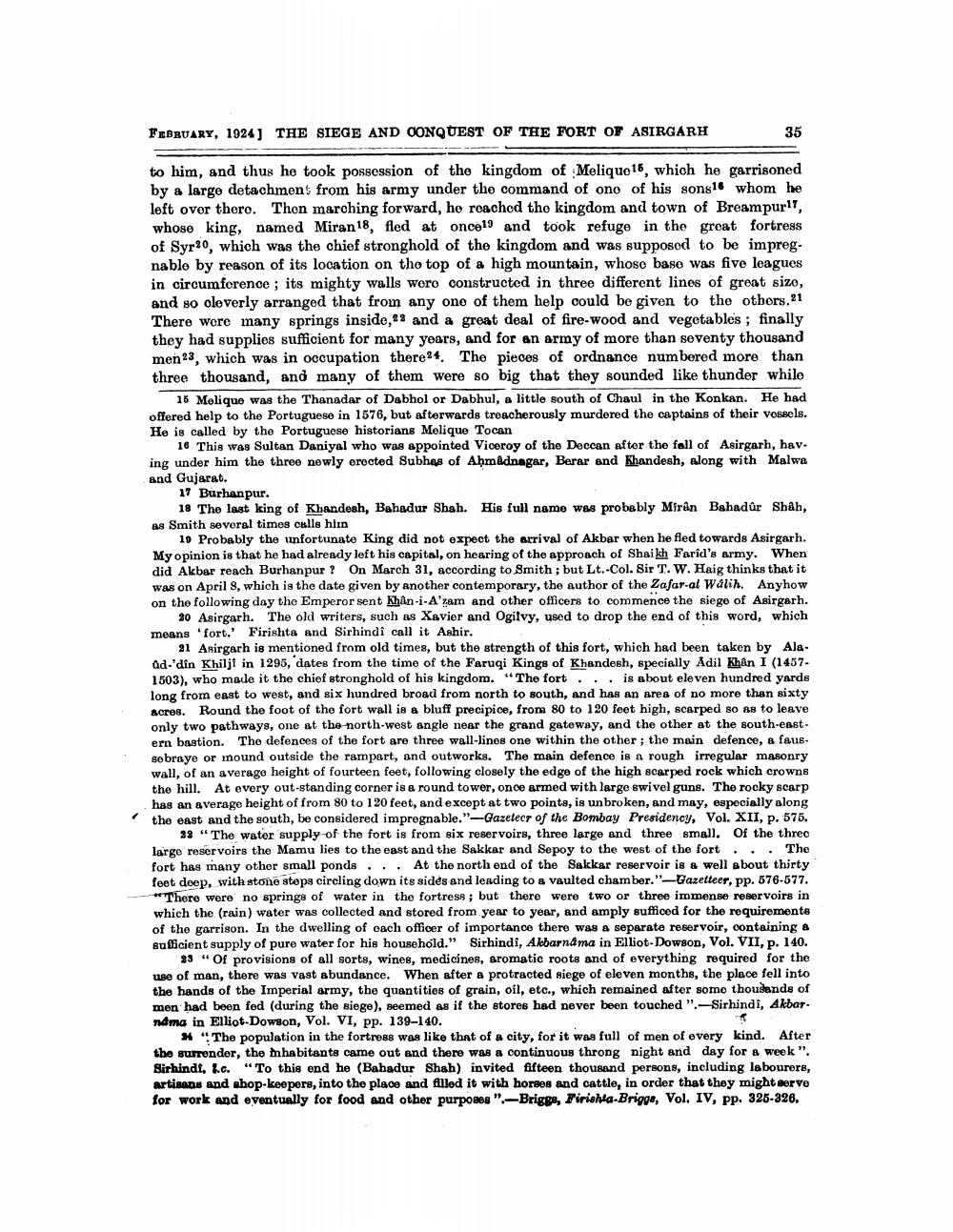________________
FEBRUARY, 1924] THE SIEGE AND CONQUEST OF THE FORT OF ASIRGARH
to him, and thus he took possession of the kingdom of Melique15, which he garrisoned by a large detachment from his army under the command of ono of his sons16 whom he left over there. Then marching forward, he reached the kingdom and town of Breampur17, whose king, named Miran 18, fled at once19 and took refuge in the great fortress of Syr20, which was the chief stronghold of the kingdom and was supposed to be impregnable by reason of its location on the top of a high mountain, whose base was five leagues in circumference; its mighty walls were constructed in three different lines of great size, and so cleverly arranged that from any one of them help could be given to the others, 21 There were many springs inside,22 and a great deal of fire-wood and vegetables; finally they had supplies sufficient for many years, and for an army of more than seventy thousand men23, which was in occupation there24. The pieces of ordnance numbered more than three thousand, and many of them were so big that they sounded like thunder while
35
15 Melique was the Thanadar of Dabhol or Dabhul, a little south of Chaul in the Konkan. He had offered help to the Portuguese in 1576, but afterwards treacherously murdered the captains of their vessels. He is called by the Portuguese historians Melique Tocan
16 This was Sultan Daniyal who was appointed Viceroy of the Deccan after the fall of Asirgarh, having under him the three newly erected Subhas of Ahmadnagar, Berar and Khandesh, along with Malwa and Gujarat.
17 Burhanpur.
18 The last king of Khandesh, Bahadur Shah. His full name was probably Mirân Bahadur Shah, as Smith several times calls himn
19 Probably the unfortunate King did not expect the arrival of Akbar when he fled towards Asirgarh. My opinion is that he had already left his capital, on hearing of the approach of Shaikh Farid's army. When did Akbar reach Burhanpur? On March 31, according to Smith; but Lt. Col. Sir T. W. Haig thinks that it was on April 8, which is the date given by another contemporary, the author of the Zafar-al Walih. Anyhow on the following day the Emperor sent Khân-i-A'zam and other officers to commence the siege of Asirgarh.
20 Asirgarh. The old writers, such as Xavier and Ogilvy, used to drop the end of this word, which means 'fort. Firishta and Sirhindi call it Ashir.
21 Asirgarh is mentioned from old times, but the strength of this fort, which had been taken by Alaad-'din Khilji in 1295, dates from the time of the Faruqi Kings of Khandesh, specially Adil Khân I (14571503), who made it the chief stronghold of his kingdom. "The fort. . . is about eleven hundred yards long from east to west, and six hundred broad from north to south, and has an area of no more than sixty acres. Round the foot of the fort wall is a bluff precipice, from 80 to 120 feet high, scarped so as to leave only two pathways, one at the north-west angle near the grand gateway, and the other at the south-eastern bastion. The defences of the fort are three wall-lines one within the other; the main defence, a faussebraye or mound outside the rampart, and outworks. The main defence is a rough irregular masonry wall, of an average height of fourteen feet, following closely the edge of the high scarped rock which crowns the hill. At every out-standing corner is a round tower, once armed with large swivel guns. The rocky scarp has an average height of from 80 to 120 feet, and except at two points, is unbroken, and may, especially along the east and the south, be considered impregnable."-Gazeteer of the Bombay Presidency, Vol. XII, p. 575. 32"The water supply of the fort is from six reservoirs, three large and three small. Of the three large reservoirs the Mamu lies to the east and the Sakkar and Sepoy to the west of the fort... The fort has many other small ponds... At the north end of the Sakkar reservoir is a well about thirty feet deep, with stone steps circling down its sides and leading to a vaulted chamber."-Gazetteer, pp. 576-577. There were no springs of water in the fortress; but there were two or three immense reservoirs in which the (rain) water was collected and stored from year to year, and amply sufficed for the requirements of the garrison. In the dwelling of each officer of importance there was a separate reservoir, containing a sufficient supply of pure water for his household." Sirhindî, Akbarnama in Elliot-Dowson, Vol. VII, p. 140.
23" Of provisions of all sorts, wines, medicines, aromatic roots and of everything required for the use of man, there was vast abundance. When after a protracted siege of eleven months, the place fell into the hands of the Imperial army, the quantities of grain, oil, etc., which remained after some thousands of men had been fed (during the siege), seemed as if the stores had never been touched ".-Sirhindi, Akbar. nama in Elliot-Dowson, Vol. VI, pp. 139-140.
"The population in the fortress was like that of a city, for it was full of men of every kind. After the surrender, the inhabitants came out and there was a continuous throng night and day for a week". Sirhindi, L.c. "To this end he (Bahadur Shah) invited fifteen thousand persons, including labourers, artisans and shop-keepers, into the place and filled it with horses and cattle, in order that they might serve for work and eventually for food and other purposes ".-Briggs, Firishta-Briggs, Vol. IV, pp. 325-326.




